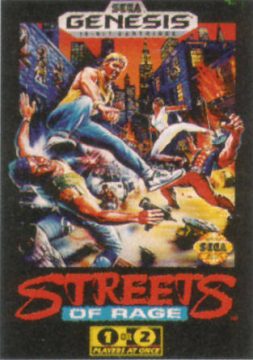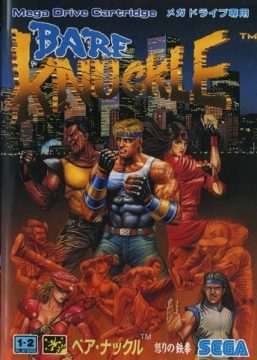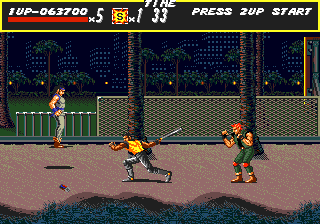Capcom revolutionized the fledgling beat-em-up genre in 1989 with Final Fight, their first brawler of many. Sega, quick to capitalize on their “Sega does what Nintendon’t” advertising campaign, would come up with a game of their own, exclusive to their own systems. It’d be difficult to say for sure whether Final Fight or Streets of Rage had the better trilogy in the end, but for a console-exclusive beat-em-up, not many come close to Sega’s franchise. The series was directed by Noriyoshi Ohba, who also helmed The Revenge of Shinobi.
Most of the series is fairly light on plot, given the nature of the genre. Things revolves around a mostly unnamed city being constantly harassed by an evil enterprise known as, simply enough, The Syndicate. This group is led by Mr. X, a powerful crime lord who seemingly refuses to die, no matter how many times people storm his penthouse and beat him into a pulp. The only two mainstays of the series are Axel Stone, a very Cody-esque “average guy” and Blaze Fielding, fellow ex-police officer and martial artist, and obligatory “fast-but-weak” type. Together, they join forces with preteens, pro wrestlers, marsupials, and electronic old men to punch a whole lot of identical looking people named “Garcia” and “Donovan”.
Characters
Adam Hunter
Adam is a boxer and the most powerful of the three characters in the first game. In fact, he’s only playable in the original Streets of Rage, with him being kidnapped in the second game.
Axel Stone
Essentially a knock off of Cody from Final Fight, with jeans and a t-shirt, along with a cool headband. He’s one of the mainstays of the series, appearing in all three games.
Blaze Fielding
Obstensibly a judo master, Blaze has a few fancy throws, but not much else. She’s slightly faster than some of the other fighters, though. Along with Axel, she appears in all three games. She also rocks the streets with her red miniskirt ensemble.
Eddie “Skate” / Sammy Hunter
Adam’s younger brother, Skate wears (appropriately enough) roller skates, making him the quickest of the lead characters. His design, complete with backwards baseball cap, most definitely dates this game as a relic from the 90s.
Max Thunder
A large sized brawler who makes his only appears in the second game. As is typical of these types of characters, he’s slow but can pack a wallop, especially with grappling moves.
Dr. Zan
One of the most unique characters in the Streets of Rage series, Dr. Zan has the face of an elderly Chinese man but the body of a cyborg. He replaces Max as the brawler character in the third game, and can also electrocute people.
At the outset, things are looking bleak in the aforementioned nameless city. The police, except for one particularly loyal guy with a rocket launcher, have all been bought out, or are too afraid to do anything. Unable to to legally take action, three cops, Axel, Blaze, and Adam, give up their badges and hit the streets in an effort to take down Mr. X. It’s a pretty serviceable plot, as beat-em-ups go, although it’s missing some of the awesome ridiculousness of the competition, like the city’s mayor personally going out to piledrive crime.
If you’ve played Final Fight, you should be able to come to grips with the control scheme fairly quickly. Tapping the punch button near enemies results in a basic combo, while moving in close puts them in a hold. Once you’ve grappled an enemy, you can pound them a couple of times before tossing them away. In something that hasn’t previously appeared in Final Fight, however, you can vault over a grappled enemy by tapping the jump button. Once you’ve got an enemy held from behind, you’re free to perform a more powerful throw, like Axel’s suplex.
There’s actually a lot more focus these techniques than Final Fight has to offer, especially since you’re given ways to counter an enemy’s own grapple attempt. If an enemy grabs you from behind, you can kick opponents in front of you or toss the enemy who’s grabbed you. Enemy throw damage can also be avoided by holding Up and the Jump button before you hit the ground. You can even throw your partner around to make them initiate a flying kick, which, while not incredibly practical, is kind of cool. While all the characters share these same moves, it helps add some badly needed variety to the list of moves, while giving the game a little more of its own unique identity.
Besides the Attack and Jump buttons, a separate input will also unleash your special move. These aren’t character-specific, and will instead call in a police car, driven by a guy the manual describes as “the one good guy on the force”. He’s apparently so loyal that he’ll drive his police car onto the beach or even onto a boat to help you out. When called upon, he’ll fire off either napalm or rocket- propelled grenades, depending on if he’s called by Player 1 or 2. This special attack will kill most mooks instantly and do decent damage to bosses, but aside from the rare pickup, each player only gets one per life. Since the characters themselves don’t get any moves meant to clear out surrounding enemies, you’ll most likely want to save this option for when you’re about to die, or when you’re fighting a boss.
Unfortunately, for all these innovations, it doesn’t take very long for the game to become stale. There’s not quite as much in the way of enemy variety as the games that inspired this particular one. It doesn’t help that the three characters play nearly identically, aside from their base stats and their animations. The highlight would most likely be the various weapons you can pick up — which includes the usual pipes and knives, but also beer bottles that smash satisfying into an enemy’s face. You’ll also find a pepper shaker, which forces enemies into a sneezing fit, which can be somewhat amusing.
The enemy AI can often prove to be frustrating, as well. Its most common tactic is to walk up and hit you, before quickly moving just out of the range of your own strikes. When they aren’t attacking, however, they generally stand still or even back away from you, forcing you to chase after them. Due to this lack of agression, the only time the enemies are actually much of a threat is when they’ve got you surrounded. The dominatrix enemies will fall to their knees for a few seconds if you jab them, which just drags out any fights they’re involved in. About the most interesting the enemies get are the jugglers you randomly encounter, who toss things like axes and torches your way.
As annoying as the rank and file minions may be, the bosses are truly exasperating. While they aren’t that much more aggressive than the regular enemies you face, they all get attacks that they can constantly spam against you, and their hits tend to do a lot of damage. Out of all the bosses, however, the one in Stage 5 is probably the one most likely to result in hair-pulling. You’re pitted against two Blaze clones, both of whom flip all over the screen, making it very difficult to hit them. They love to suplex you when you get close, and pull off jump kick after jump kick if you put too much distance between them. The final boss encounter is even more cruel, as it faces you off against a boss rush without the ability to call in for backup.
There are eight stages in total, but they all tend to feel like the same stretch of screen with a different background until you encounter the boss. Some of the levels have some interesting features, though. There’s a factory area, something this game has over the SNES version of Final Fight, where there’s the occasional press that can come down upon you or your opponents. Some levels also have the occasional pit you can toss your foes into, or end up falling into yourself, if you’re not careful. Naturally, there’s also an elevator, because it’s a beat-em-up. It’s the law. In this one, however, there are no walls, meaning you’re free to chuck enemies to their hideous demise on the ground below. Just don’t get thrown off, yourself.
The final stage has a pretty interesting twist, as well. Mr. X awaits you at the end, but instead of attacking right away, the game opens up a previous unseen dialouge box. He’ll use this to ask if you want to become his right hand man, giving you the choice on how to respond. Choose yes, however, and you’re dropped down a trap door back to Stage 6, forcing you to fight all the way back to the final room once more. The trick is to bring two players, and when the question comes, the two players must disagree.
This leads to a battle between the two players, which only ends when one of them loses all their lives and continues to the winner. If the player who accepted Mr. X’s offer manages to beat him, you get a secret ending in which your character takes Mr. X’s throne for himself and becomes the city’s new ruler. As difficult as it is to get this ending, it’s a particularly cool touch.
In terms of visuals, some of the backgrounds are rather nicely detailed, even if they can get rather monotonous. A few stages are nothing but the same stretch of land, constantly looping until you finally reach the boss. The character sprites are tiny, compared to other games in its genre, with the bosses being the rare exception. The frame rate also feels somewhat choppy, possibly since the game only runs at 30 FPS — a rarity for a 2D Genesis game.
If there’s any reason to play this game over its superior sequels, though, it would have to be Yuzo Koshiro’s classic soundtrack. His music, inspired by club and techno hits of the time, fit the Genesis’s particular sound hardware well. The highlights would probably have to be the tracks for the first and final stages, although there’s more than few good tracks on your way to the end. The sound effects are rather weak, however, and the digitized voices are rare and scratchy. Interestingly enough, a few of the sound effects were taken straight from Sega’s 1989 game The Revenge of Shinobi.
While it certainly looked much more impressive when compared to the paltry SNES port of Final Fight, unfortunately, there’s not much reason to come to this first entry now. It’s more than functional, but lacks the variety, controllability, and unforgettable music later games would offer. Thankfully, later sequels would see massive improvements.
The Master System version looks and feels surprisingly similar to the Genesis version, even if there are a few downgrades along the way. Only three character sprites are ever on screen at one time, which includes your player character, meaning that there’s also no co-op. It makes for a slower, less difficult game overall, and one where a lot of minor differences will jump out at big fans of the Genesis version. Your basic combo is a little slower, and your neutral and forward throw attacks are swapped for example. Despite this, it’s a solid port that has nearly everything included, some nice 8-bit renditions of the Genesis version’s tracks, along with some new ones.
Unfortunately, the same can’t be said for the Game Gear version, which is entirely different from its Master System counterpart. While there’s a two player option through the link cable, Adam is missing entirely. On top of that, this version feels off in an assortment of ways — horizontal jumps have nearly no momentum, you can no longer perform forward or neutral grab attacks at all, and it’s a gamble on if your basic combo will actually come out as intended or not. With the police attack missing entirely, this doesn’t things much easier at all. It makes for a very unpleasant feeling experience overall, even if it’s three stages shorter than the Genesis version. About the only real high point is that it keeps the same music as the Master System version, which means it comes out sounding pretty all right.
The original Streets of Rage was also featured on Sega Classics Arcade Collection 5-in-1 for the Sega CD. This release is almost exactly the same as what you’d get on the Genesis.
The 3DS version, handled by M2, is a perfect port of the original Genesis version with a few extra features. The 3D here is rather unique – many of the other Genesis ports simply assigned depth to the parallax scrolling backgrounds, but Streets of Rage rarely uses these. Instead, it assigns depth to the playing field, making it look like a 3D stage. The effect looks outstanding, and it’s definitely the best looking of the Genesis 3DS ports. There’s also an added easy mode called “Fists of Death”, which makes it so all enemies go down after one hit.
The original game has appeared on a few collections, like the Japanese version of Sonic Gems Collection. Unfortunately, it was removed from the Western versions to maintain an E-rating for the collection. However, all three games are available on Sonic’s Ultimate Genesis Collection for the PS3 and 360. On the PC side of things, it’s also been released for Steam. These are all mostly just the game running on an emulator, though.
The best way to play the original SoR has to be the Sega Vintage Collection on XBLA, which includes all three Streets of Rage games. These are more accurate emulations, come with some great extra features like leaderboards, and online play. This version includes a variety of display options, both the English and Japanese versions of each game, and three new music tracks used for the menu screens.
The working title for Streets of Rage was DSWAT. This was to signify the idea that it took place in the same universe as ESWAT, an earlier Sega game. Observant players may notice that the cop car from the ending of ESWAT on the Genesis is the same as the support car in Streets of Rage.
Screenshot Comparisons




